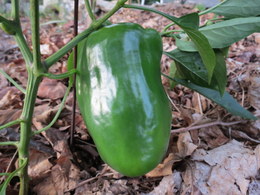Pepper Growing Guide

Peppers (Capsicum annuum) are popular with home gardeners. They are native to South America and require full sun, warm weather and need a long, warm growing season. Whether you are planting sweet or hot peppers, wait until the ground warms up before planting.
There are many sweet and hot varieties. The garden centers only carry a limited number of varieties so you may want to consider growing your own from seed.
The sweet varieties can be found in colors ranging from green, yellow, purple and yellow. Some are especially suited for stuffing. The green ones if left on longer will turn red and taste even better. Most of the hot varieties are picked when they are red.
Starting from Seed
Peppers do best when the air temperature and soil temperature have warmed up. This is usually 1 to 2-weeks after your last expected frost date. Counting back 6 to 8-weeks is the time to start your pepper seeds.
Follow the instructions on the seed packet. Sow the seeds evenly and thinly in a sterile seed starting mix in cell packs or pots.
Germination may take 10 to 21-days. Using a seed starting heating pad and watering with warm water, not warmer than 105-degrees F, will help speed up the process.
For more detailed information visit the seed starting page.
Soil Preparation
Peppers will grow best in good loose organic garden soil. As soon as the soil is frost-free and can be worked, till the soil by digging down 8 to 12-inches turning the soil over with a garden fork. Remove any large rocks and stones. The small stones remaining will do no harm and actually benefit the soil by adding some micronutrients to the soil. Peppers do well when the soil pH is in a range of 5.8 to 6.8.
Planting Peppers
Plant them in the garden after all danger of frost. Waiting 2 to 3-weeks after your last frost date is a good time to plant. They require full sun and should be spaced 18 to 24-inches apart.
They can be planted 1 or 2-inches deeper than the pot they were grown in. As they grow the weight of the fruit may cause the plant to tip over. Give them some support with a short stake or a small tomato cage to hold them up.
Put up your method of support while the plant is still small so that you do not cause any root damage.
Watering and Care
When the plants are a few inches tall add a nice loose mulch of shredded leaves or pine straw to shade the plant roots. This will keep the weeds out, the soil cooler and help retain moisture. Keep the mulch a couple of inches away from the stem. During dry spells give some water each week.
Fertilizing
When the flowers appear you can feed with a balanced vegetable garden fertilizer.
Harvesting Peppers
The bell peppers can be picked when they reach full-size and are still green. If you leave them on longer they will turn a nice bright red color and become sweeter.
Picking them when in the immature green stage will stimulate your plant into producing more. To prevent damage to the stem it should be cut from the stem.
Hot peppers are usually left on until they are a mature bright red, but there are some varieties that are harvested while green.
Popular Sweet Varieties
Bell Boy, Better Belle, California Wonder, Cardinal, Early Pimento, Golden Bell, Golden Summer Hybrid, Gypsy, Jupiter, Nardello, Orange Blaze, Red Majesty, Sweet Banana, Sweet Yellow, Yolo Wonder.
Popular Hot Varieties
Anaheim, Cayenne, Hungarian Wax, Hungarian Yellow Wax, Jalapeño, Ring of Fire, Serrano Chili Pepper, Shishito, Tam Mild Jalapeño.
Sources: Seeds Now, Burpee, Johnny’s Selected Seeds
Diseases
There are some diseases of peppers that affect the foliage. These are: Anthracnose, Cercospora leaf spot, Alternaria leaf spot, Bacterial leaf spot, Early blight, Verticillium and Mosaic. Many of the diseases that affect peppers also affect tomatoes and eggplant. The best way to prevent damage is crop rotation and keeping your garden free of crop debris. Pick up any dead leaves on the ground and trim off any leaves that look diseased and put in the trash, not your compost pile.
Pests
Aphids, Corn earworm, Colorado potato beetles, Hornworms and Cutworms.
Aphids are known to be the major cause of transmitting diseases. Using a garden hose to blast off the aphids is a quick and easy way to control them. Examine your plants often and remove any that you find.
For organic gardeners with serious problems, insecticidal soap or neem oil can be used. Always read and follow the instructions on the label.
Tips and Warnings
Do not plant your peppers in the same place 2-years in a row. Mulch after planting with shredded leaves or pine straw. Keep the soil moist and water weekly during dry spells.
Garden Spikes newsletters give you timely information once or twice a month. Subscribe Free to the Garden Times newsletter below.
Your email address will only be used to send you a newsletter and will never be sold. You can unsubscribe at any time.
